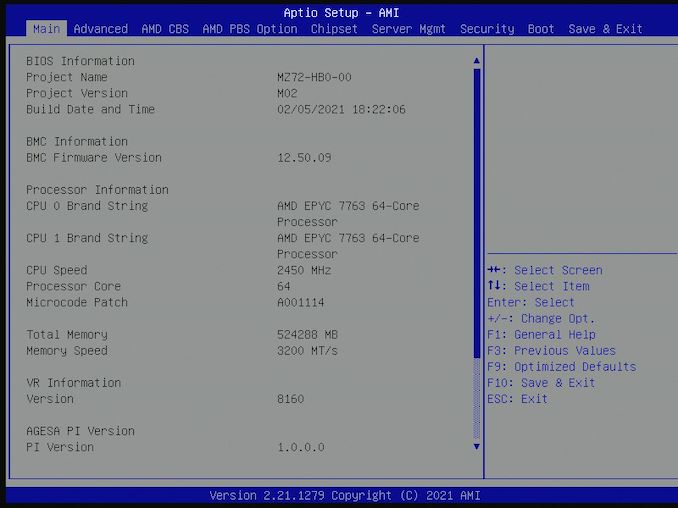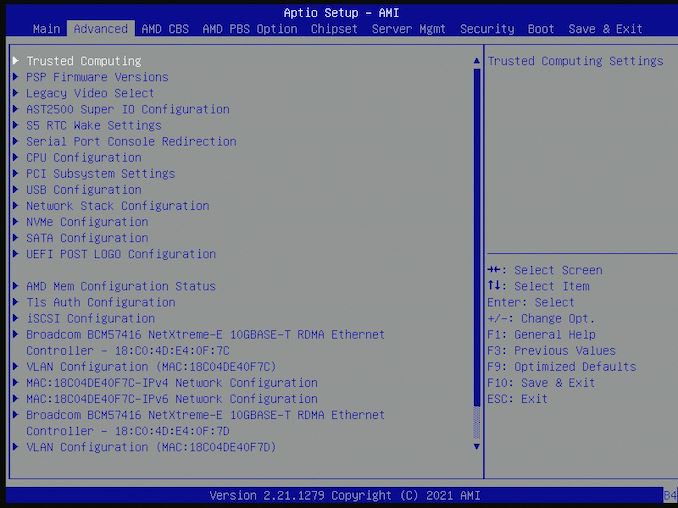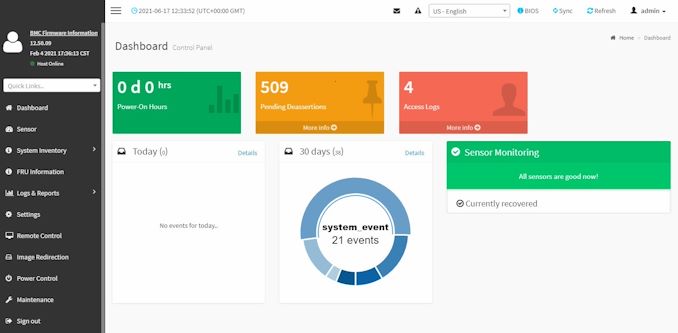The GIGABYTE MZ72-HB0 (Rev 3.0) Motherboard Review: Dual Socket 3rd Gen EPYC
by Gavin Bonshor on August 2, 2021 9:30 AM EST- Posted in
- Motherboards
- AMD
- Gigabyte
- GIGABYTE Server
- Milan
- EPYC 7003
- MZ720-HB0
BIOS
When it comes to the firmware on the GIGABYTE MZ72-HB0, it's nothing fancy, flashy, or glossed over for consumers to eyeball. It is using a basic and archaic-looking Aptio AMI firmware version, which focuses on functionality and substance over style. The GUI is basic, with a deep blue edging and scroll bar, with the help menu text in the bottom right-hand corner also in the same blue. The text is a well-contrasted black with a light grey background, which makes everything easy to read.
Entering the firmware, the main screen has a basic list of information that includes the firmware version that is currently being used, as well as basic information on the processors installed; in this case, two AMD EPYC 7763 64-core and 128-thread Zen 3 processors. It includes the base clock speed, as well as the core count, and also includes a combined total of installed memory with its speed in MT/s (it's great to see some vendors using the correct definition of Megatransfers per second).
The BIOS itself has very deep and contrived menus and options for users to delve into. Along the top, there's the Advanced section with options for Trusted Computing, ASPEED BMC configuration, CPU, USB, PCI, and storage configuration. Users can also alter and customize the MAC address settings for gaining access to the system across a network using the Gigabit Management Ethernet port on the rear panel.
Other menus include the AMD CBS and PBS options for power limitations, and altering Precision Boost Overdrive settings, while the Chipset menu includes options for enabling or disabling the PCIe compliance mode. There's also a dedicated menu for Server Management, where users can also configure the BMC networking settings, as well as view FRU information. The Security menu allows users to enable a firmware level administration and user password, especially if they want to keep non-essential users out of core settings, while the Boot menu allows users to customize the boot and POST order of any installed storage devices.
Overall the firmware on the MZ72-HB0 is functional, and with options aplenty, there's a lot of substance for users of multiple disciplines, including cloud, server, and workstation users.
Software/BMC
Although the GIGABYTE MZ72-HB0 doesn't come with a software bundle per se, it does include access to its MegaRAC SP-X browser-based interface. It includes both a JAVA and neat HTML5 based user interface, and GIGABYTE adopts a more modern look than previous years of its server-focused models.
The GIGABYTE MegaRAC SP-X interface includes all the typical options of a board of this caliber should, including system inventory which shows the user's installed CPU, memory, storage, PCIe, and NIC inventories. Users can also look at the detailed information of the components in each of the subsections, as well as associated and supported technologies that can be used with the installed processor including hyperthreading, Execute Disable (XD), and if turbo mode is functioning or not. The MegaRAX SP-X interface also allows users to use BMC functionality, as well as powering up or down a system, as well as capturing BSOD, which is particularly handy if something isn't running as stable as it should.
There's also a load of security, power-related, and logging options available for users to sink their teeth into. As a board of this pedigree and for its functionality in server, workstation, and more intensive use cases such as cloud servers, it looks to be fully equipped from an access interface point of view. Users can even flash the board to the latest version of the firmware over the interface and BMC, as well as save and load up pre-saved configurations for deploying the same settings across multiple servers/systems.
Overall the GIGABYTE MegaRAC SP-X is functional, easy to navigate, has a plethora of options for users to monitor and alter, and it's very good to look at too.

























28 Comments
View All Comments
watersb - Tuesday, August 3, 2021 - link
Awesome, I always learn something here!The 20A receptacles aren't all that unusual, a good commercial-grade 20A is in regular stock at my local hardware store... and I live in a remote small town.
Mikewind Dale's suggestion is sound: run a 20A if you're putting anything new in. Just be certain you don't string that behind an older 15A breaker! Should be a home run from your receptacle direct to the panel. Don't know if isolated ground specifically makes a difference, but it would likewise be a trivial cost.
Does anyone make a 20A ATX power supply? They are more common in the data center, and one of my home rack PDUs showed up in the 20A version. (Then I got a Raspberry Pi, and replaced two servers with my MacBook Pro M1, and the power delivery system looked a bit embarrassed. So of course it's time to buy more silly gear...)
Foeketijn - Wednesday, August 4, 2021 - link
I never understood why the US never changed the voltage system. The reason the US still uses 110V dual phase, is because after supporting World wide triple phase 220V the government found out it saved loads of copper. And the copper industry was depending on using that much copper.But nowadays the Chinese make the copper anyways.
3600W from a normal fuse. 11kW from a normal triplephase 3 fuse outlet is your house has triple phase.
Being wary about fuses just is not a European/Asian thing. Nor should it be American
mnemotronic - Tuesday, August 3, 2021 - link
Server board? Please tell me it supports ECC memory.Mikewind Dale - Wednesday, August 4, 2021 - link
It supports RDIMM and LRDIMM. Although that's not the same as ECC, it's pretty much 100% correlated with ECC. I've never heard of a server board that supports RDIMM and LRDIMM but not ECC.Heck, most ThreadRipper non-Pro boards support ECC, and many Ryzen boards do. It would be unthinkable for this board not to support ECC.
Mikewind Dale - Wednesday, August 4, 2021 - link
And just for comparison, Gigabyte's ThreadRipper Pro WRX80-SU8-IPMI board says "Support for UDIMM (ECC), RDIMM, 3DS RDIMM and LRDIMM memory modules". Notice that "ECC" is a qualifier for "UDIMM". It appears that for Gigabyte, ECC is only a question for UDIMM; for RDIMM and LRDIMM, ECC goes without saying.bananaforscale - Friday, August 6, 2021 - link
"Size E-ATX"There's "larger than ATX" but there's no E-ATX standard.
Axel_K. - Tuesday, August 10, 2021 - link
When will this motherboard be available at online retailers? By googling I find that it is widely available only in Russia. When will it be available in the US and other countries?MirrorMax - Saturday, August 28, 2021 - link
Few errors in the article. Epyc rome already had 280w cpus with the 7H12, which was supported on the rev1 board. and there's nothing new on the rev3 board except a rome/milan bios instead of the naples/rome bios from what I can see. I assume they couldn't fit all 3 gens into one bios. Rev1 boards are also flashable to milan/rome bios according to gigabyte support. they are not too happy about customers bios flashing unless they have issues so i assume thats why they released this a seperate Rev not just a bios update.